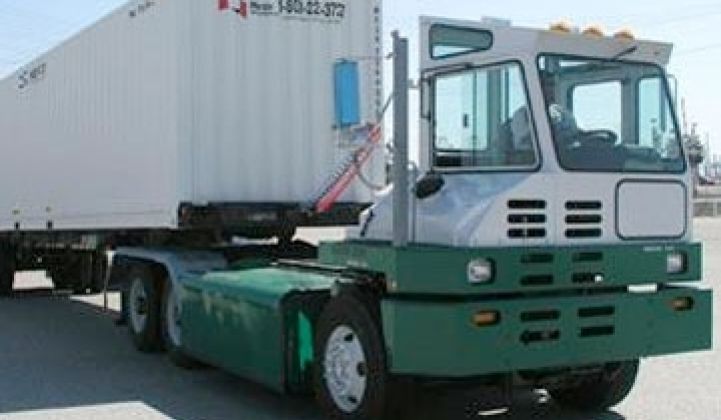Balqon Corp. thinks it might have an early counter-claim to T. Boone Pickens' contention that trucks can't run on batteries alone.
Well, the Harbor City, Calif.-based maker of electric vehicle drive systems isn't saying it has an all-electric semi tractor-trailer rig ready for the highway.
But Balqon does have a new truck, called the Mule M150, that it says can go 150 miles unloaded, or up to 90 miles loaded with seven tons of cargo, on a single charge of its new lithium-ion battery pack.
A 90-mile range won't serve to replace diesel-fueled big rigs – a point that T. Boone Pickens, the oil tycoon who's pushing for natural gas as an alternative fuel for big rigs, is fond of making (see Pickens Wants Natural Gas-Fueled Big Rigs).
But it could open up markets beyond the short-haul, dockside applications the truck was originally developed for, Balqon CEO Balwinder Samra said – say, inner city food and beverage delivery or trash hauling.
It does cost about $100,000 more than its typical, $130,000 diesel-fueled equivalent, he said. But if you think of the price of its battery and electric drive as the up-front cost of fuel the truck will use throughout its life, it will save enough to make up the difference in about five years or so, Samra said.
Balqon was founded in 2005 to develop traction drive systems for heavy vehicles. But in 2007 it got a $400,000 grant from the Port of Los Angeles to deliver a complete all-electric vehicle – a "yard tractor" meant for carrying cargo containers unloaded from ships by cargo cranes to storage yards.
Ports are becoming an early proving ground for electric heavy-duty vehicles, since they combine relatively short-range operations with a pressing need to reduce the pollution from their operations. Several other projects are underway to bring lower-emission vehicles into more widespread use at ports (see Hybrid Seaport Tractors Aim for Idling Time Fuel, Emission Savings).
"There's a lot of stuff happening in the area of yard trucks," said Michael Ippoliti, clean transportation solutions director at CalStart, a nonprofit group that promotes clean transportation.
Those include hybrid electric trucks from Troy, Mich.-based ArvinMeritor and Longview, Texas-based Capacity of Texas, as well as hydraulic-hybrid trucks that use pressurized fluid instead of electricity for power, he said (see Hydraulic-Powered Trucks Hit the Road).
Balqon also was asked by the Port of Los Angeles to deliver a "drayage vehicle," or a truck that can carry cargo containers from central yards to train or truck depots some miles away. That's the role for which the Mule M150 was built.
To deliver the higher speeds and ranges that it requires, Balqon decided to switch from its previous lead-acid batteries to lithium-ion batteries, Samra said.
"Fortunately, we have the luxury of space, so we were not looking for the most exotic, high energy-density battery that needs to be packed into a small area," as with an electric passenger car, he said. Balqon assembles its battery packs using lithium-ion cells from a Chinese company that Samra declined to name.
The Port of Los Angeles gave Balqon another $400,000 grant in May to develop those lithium-ion battery powered trucks, which it did in partnership with heavy vehicle maker Autocar. In June, the company tested out the first of those vehicles, demonstrating their new, longer-range capabilities, Samra said.
"That was sort of a game-changer for us," he said. "We were thinking short haul, but now you could almost think medium-range type vehicles. All of a sudden, inner-city applications looked doable."
While the market for on-port vehicles is "significant enough for a niche player like us," the larger market is for short-range delivery trucks, or so-called Class 7 and Class 8 trucks, he said.
California has about 100,000 trucks that could be classified short-haul in terms of usage, he noted. Of course, not all of those will be suited to all-electric operations.
For example, electric vehicles tend to be more efficient for situations like driving in heavy traffic with lots of stops for deliveries, rather than for longer hauls from one place to another, he said.
"The people who will make progress in this area will be niche players who are nimble and can customize" vehicles for specific uses, he said. "Fortunately, the experiences we have had being in the niche markets, we are able to explore all those opportunities."
Companies seeking to fill that market will also have to pass the test of dong the job that customers need them to do, Ippoliti noted.
"If it's some kind of hybrid that doesn't have the pulling power they need, they won't use it," he said. "If it's an electric that runs out of steam before the end of a shift, they won't use it."
Other battery makers are targeting fleet vehicles like trucks and buses before tackling passenger cars. Fleets tend to refuel (or recharge, as the case may be) at central depots, making the issue of charging stations less of a challenge (see Valence: Electric Buses and Trucks First, Cars Later).
The big rig market isn't being ignored by battery makers either, though for now they're looking at niche applications like powering semis while they're idling at truck stops (see Quallion Seeks DOE Grants for 'Anti-Idling' Batteries).
Image courtesy Balqon.



